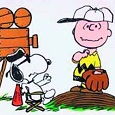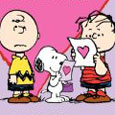United Features Syndicate/Lee Mendelson Films/Cinema Center 100 Productions (December 4, 1969), CBS DVD/Paramount Home Entertainment (March 28, 2006), single disc, 86 mins, 1.78:1 anamorphic widescreen, Dolby Digital 5.1, Rated G, Retail: $14.99
Storyboard:
The lovable loser from Peanuts stars in his first movie, as he spies glory while competing in a spelling bee.
The Sweatbox Review:
Peanuts is a dichotomous little creation: a humble, musing and often melancholy humor strip that somehow became a huge franchise which would eventually conquer the fields of the newspaper comic strip, television specials, the stage, and mass merchandising. Naturally, all of its success has to do with the genius of Charles Schulz, who tapped into something very special with his creation. With all that, one would think that Charlie Brown and the gang would have seen some big-screen success too, and in fact they did; but it has been so long since their movies came out that one could not blame the casual fan for forgetting them or younger fans for not knowing of them— particularly since their movies have until recently been absent from DVD shelves. Personally, my memories of their four movies is a bit hazy, except for Race for Your Life, Charlie Brown, which for some reason seems to have had the greatest exposure on television.
The first of the Charlie Brown movies, however, was A Boy Named Charlie Brown, which came out just a few months before my birth, premiering in time for Christmas of 1969. By this time, the first six television specials had aired, celebrating Christmas, baseball, Halloween, love, dog ownership, and summertime. The movie chose to examine a staple of Peanuts stories, Charlie Brown’s quest for self-assurance and acceptance by his peers. Those first few television specials were all classics, so I was expecting to love the movie just as much when I played the DVD. Unfortunately, it was a little too much like the TV specials, in that it too had about twenty minutes of good material; too bad the movie lasts almost an hour and a half!

The movie starts out similarly to many of the specials, appearing to be somewhat episodic although generally focusing on how much of a lovable loser ol’ Charlie Brown is. Eventually, a plot emerges, as Charlie Brown shows himself to be a pretty good speller at the school’s spelling bee. He wins his school’s competition, and basks for the first time in the adoration of his classmates. It is a moment that Peanuts fans have to enjoy, as that stupid bald-headed kid finally got something right. Of course this couldn’t be a Charlie Brown story if it ended there. That would ruin the whole character, and he still had another few decades of comic strips and TV specials to be portrayed as a failure.
Soon, Charlie Brown finds out what everyone else apparently knew— winning the school competition is just the first step. Next is the National Elimination Spelling Bee! Self-doubt and desperation immediately come to the forefront again (now that’s the Charlie Brown we all know and love!). There can be little doubt that tragedy will follow, and the fun comes in seeing it unfold, and in seeing just how close Charlie Brown can get to victory before ultimately failing. The scenes of him competing in the state competition are classic, with a healthy dose of anticipation as to how he will ultimately screw up. And when the moment comes, it is perfect. As Linus and Snoopy watch from the audience, and the rest of the gang views the spelling bee on television, we all feel for good ol’ Charlie Brown.
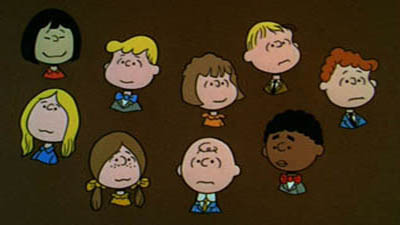
Naturally, creator/writer Charles Schulz and his animation production team of Mendelson and Melendez make this story about more than just a kid failing for the umpteenth time. It is always a little heartbreaking to see Charlie Brown fall, but we are given comfort that it is okay to fail. Even though it may seem unfair that some of us fail more than others, failure is a part of life, and any one failure is unlikely to mark us for life. And if Charlie Brown’s friends seem unfortunately cruel in their disdain, we all really know it is only because they secretly like and maybe even admire him just for trying. Charlie Brown is constantly putting himself out there, and repeatedly trying to accomplish tasks that have proven time and again to be beyond him, and yet he perseveres.

Now, that would all make for a pretty good TV special. The movie, however, is terribly padded with a number of musical numbers that often do nothing to advance or even recognize the story. Even that could be forgiven, if the direction and art stylings were at all interesting, but they are decidedly not. I realize that with a property such as Peanuts, one does not wish to go overboard on making the visual style too splashy, but neither is it necessary to stage everything in the most boring way imaginable. And yet, much of the movie seems to do everything possible to remain non-animated. And I am not referring to the quality of the animation itself, which is generally satisfactory; I refer instead to a steadfastness in avoiding anything that takes advantage of the cartoon medium… or even the film medium, for that matter. (Actually, I should not be too quick to stick up for the animation. While the characters move well enough to suit the movie, this film features some of the most off-model Peanuts drawings that I’ve ever seen!)
When the film does try to do something more with the animation, it tends to be simply conceived video tricks… flashing squares, and some mildly interesting split-screen stuff. A montage that goes on while Schroeder plays a solo is at least ambitious in its effort to go with a totally different visual style, but falls short due to the artists over-reaching themselves. Even in standard scenes, the composition is often poorly done, with large patches of open space in the picture. It just looks like a slapdash production. Like Charlie Brown, the artists’ grip exceeded their grasp.

And yet, I cannot totally dismiss the film. As Charlie Brown’s big screen debut, it is somewhat historical. Also, the main storyline of the spelling bee is really among the best ever seen in Peanuts cartoons. The thing to do is to try to ignore the movie’s faults and keep your remote handy to pass over at least a couple of the musical numbers.
The DVD does do one major thing right. The DVD preserves the movie’s original runtime of 86 minutes, in contrast to the 79-minute cut shown previously on home video and in television syndication. After all these years, we finally get to see Lucy giving Charlie Brown a replay of his missed football kick, a full telephone conversation between Charlie Brown and his hotel’s room service, and several scene extensions.
Is This Thing Loaded?
How barebones is this disc? Well, Paramount didn’t even bother to put some Nickelodeon trailers on here. (Maybe DVD co-producer CBS had something to do with this.) It’s really too bad that Melendez, for example, was not tapped to do a commentary or even a short introduction.
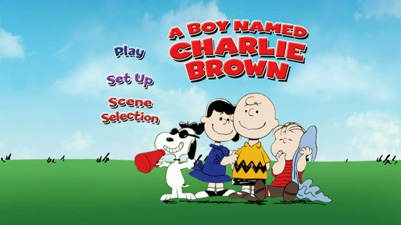
Case Study:
Basic keepcase, no insert, bland art. Using a theatrical poster would have been much, much better on the cover.
Ink And Paint:
Paramount has elected to go with an anamorphic widescreen presentation for this movie, matching the 16:9 widescreen television ratio. This would roughly duplicate the image that was shown in theaters in 1969. It does, however, crop off the top and bottom of the image, since the Peanuts movies were originally made in the 4:3 ratio from what I have read. So, the “true” aspect ratio is up for debate. Personally, I never mind seeing a film in its theatrical ratio, so this DVD’s ratio suits me fine… almost.

I did not miss the image lost at the top and bottom of the screen; but oddly, the framing on the sides seemed to me to be too tight, as I did actually note many instances of cropping on the sides. This was most noticeable when words are cropped off when they are obviously meant to be readable, and even when characters have only half their heads showing at the side of the frame when there is still plenty of other room in the frame’s composition. One wonders why this could not have come out better.
Also, I was disappointed in the overall clarity of the picture. The movie is grainy and indistinct, and the color timing appears “off”. While quite possibly looking better than any prior videotape versions, it is far from the quality of, say, the DVD for the similar vintage Pinocchio In Space. I can forgive the numerous specks and smudges that may have been a part of the original camerawork or the cels themselves, but even aside from that this dull, scratchy image is simply substandard. Add in some edge enhancement halos and truly drab colors, and there is not much to get excited about.
So, points are given for using a non-edited, widescreen transfer, but points are taken back again for an overall less-than-mediocre picture.
Scratch Tracks:
In a bit of a surprise, a 5.1 Dolby Digital soundtrack is offered here. While expectations should be appropriately managed, the 5.1 track does fill things out somewhat when compared to the also-included Stereo track. There’s no low end to speak of, of course, but the 5.1 track does manage to create a nice bit of ambience with the music, as well as a few well-placed sound effects.

Speaking of the music, I did find it bizarre to have to do without Vince Guiraldi’s music for so much of the movie. His stuff is in there, naturally, but it has to share space with additional music and songs by Rod McKuen. Frankly, it just doesn’t feel like a Peanuts cartoon if it has music that isn’t dominated by nifty piano jazz. (Even though the music was Oscar nominated.) And, it would have helped if the musical parts added more to the story. Instead, several of them feel tacked-on, as if they were only put in because an animated film needs to have musical numbers. The Star-Spangled Banner bit in the beginning was extraneous and uninteresting; a Schroeder solo starts out as a unique animation experiment; but just as the limitations of the artists becomes woefully apparent as they attempt to “class up” the picture, you realize that there is not even any reason for the sequence to appear in the film, and worse yet— it’s boring.
There is that “I Before E” song, though, which is pretty good. This song goes over that well-known rule of English spelling, with Linus attempting to instruct Charlie Brown. If the rest of the songs had been that good and well integrated, the movie would have been much better.
There are no other language tracks or subtitles offered.
Final Cut:
Properly edited, this would have made a superior television special. Instead, this movie is bloated and too often boring. Peanuts fans will still wish to see it and will certainly find parts to enjoy. The full, unedited version is great to see after all these years, but the dingy video quality and lack of any bonus material makes this a disc for only fervent yet undemanding fans. All others may be disappointed in this DVD. I know I was. Still, I’m glad to have a copy of this movie at last. Despite everything, I still love that boy named Charlie Brown.
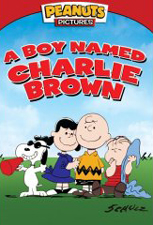 | ||
 |








